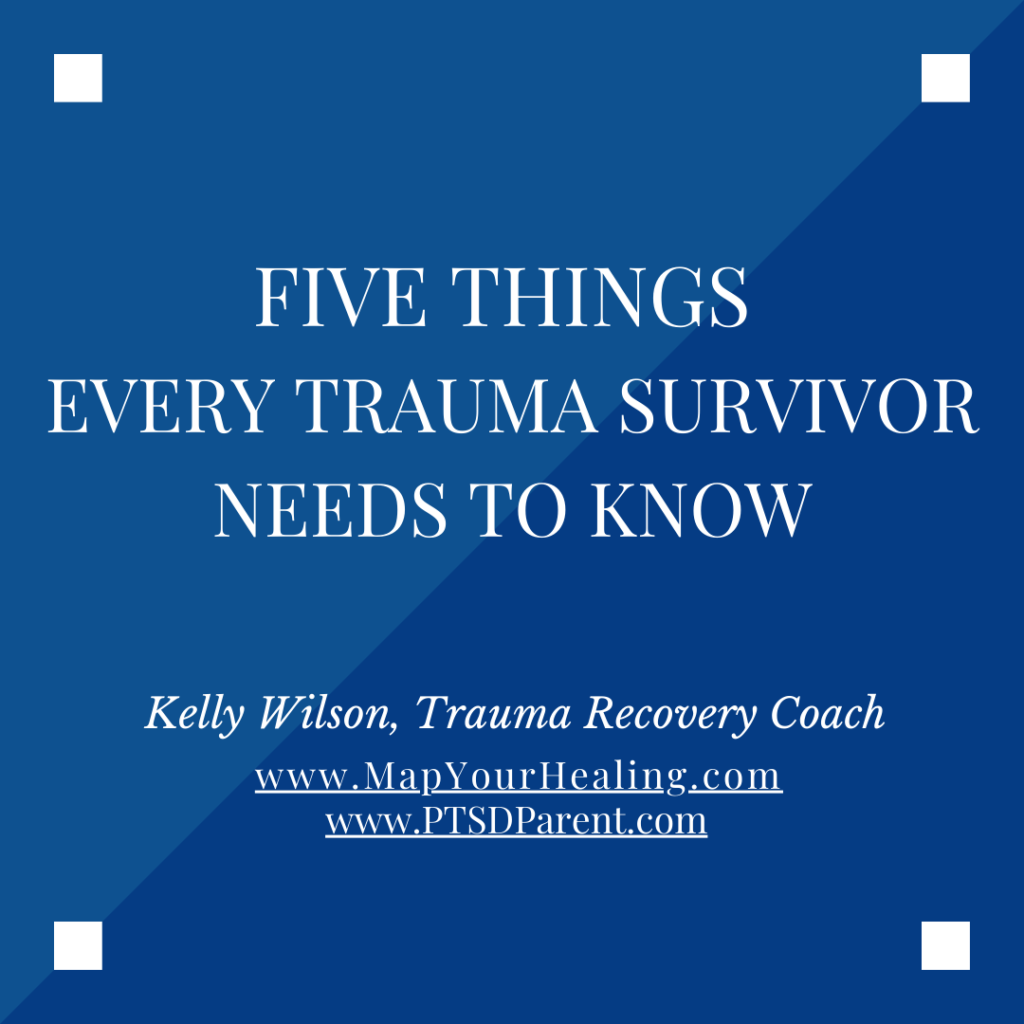The post Making Mother’s Day a Peaceful Holiday appeared first on PTSD Parent.
]]>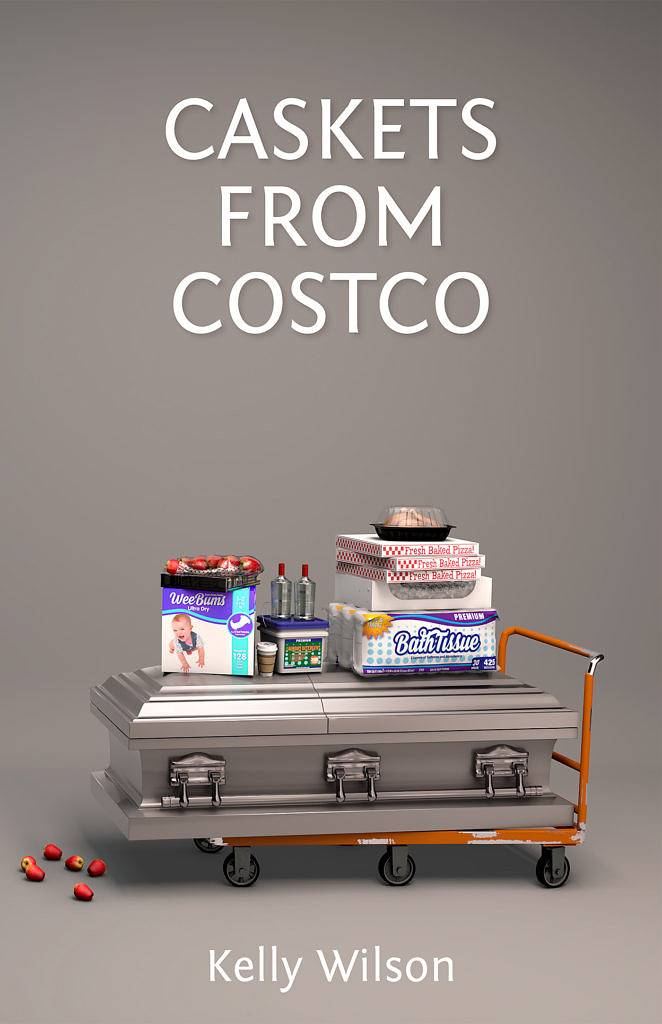
I am estranged from my mother (and other family members) due to past family trauma.
I am a survivor of childhood sexual abuse by my father. When I was 16, I disclosed this to my mother through a series of truly unfortunate events (details can be found in Caskets From Costco). We pursued legal action, and nothing happened – meaning, he was not convicted or trialed or jailed or anything like that.
A few months later, through another series of unfortunate events, he showed up at our home. My mother took him back, over my protests. A few weeks after that, he walked away, got a divorce from my mother, and married somebody else. So, yeah, Mother’s Day can be tough.
There are many reasons that this holiday can cause discomfort and pain. Here are some tips to help manage PTSD around Mother’s Day.
Make a Mother’s Day Plan
One of the ways to manage ourselves and PTSD triggers during Mother’s Day is to make a self-care plan. Here’s an example that might help.
Acknowledge what is difficult about the day. If you wake up and you can tell it’s a tough day, acknowledge that reality. Simple acknowledgement goes a long way toward peace.
Decide what you will not do. Many times, deciding what you will not do is far easier than figuring out what you like or want to do. For instance, I will NOT be doing the dishes that day.
Schedule everything, including rest, for that day. Figure out what you’d like to eat, do, and even wear (pajamas, anyone?)
Ask for help. Manage expectations, including your own. If you want or need something, ask a safe person in your life to help you out.
Focus on what you love. I don’t mean toxic positivity, where you pretend that you’re happy and “everything’s fine.”. I mean finding one tiny (or big) thing during a moment that you love. Maybe it’s the taste of chocolate on your tongue or the feel of your favorite sweater.
Making a plan is one of the proactive ways to manage triggers on a day of emotional landmines. This can help you stay present, which can be really difficult to do with PTSD.
Seek Peace with Grounding Techniques
One of the toughest things to do when having a trigger is becoming aware of it either right before it happens or when it’s happening. Awareness of triggers can help build in pauses – maybe the tiniest of pauses – where we are reminded to ground ourselves.
Here is a video I made of a breathing exercise that I like to do when I feel agitated.
Other easy grounding exercises include the 5-4-3-2-1 and the what I call “the color picker.” In the 5-4-3-2-1, count 5 things you see, 4 things you hear, 3 things you can touch, 2 things you can smell, and one thing you can taste. With “the color picker,” look around and count how many things around you are red (or another color, if you prefer).
In a trigger emergency, I’ll share a secret with you that one of my therapists taught me. If you are agitated and feeling out of control, stand up and spin or twirl 10 times in a row. This taps into the where the vagus nerve hits the inner ear, and gives us a reset.
Be Gentle With Yourself
No matter what, let’s be gentle with ourselves.
We deserve peace, especially on Mother’s Day.
About Trauma Recovery & Grief Recovery Coaching
Kelly Wilson of PTSD Parent is a Trauma Recovery Coach and Grief Recovery Specialist. In 2020, she worked with a therapist and completed PTSD Remediation, a technique that uses the vagus nerve to eradicate PTSD triggers.
Sign up here to get a free copy of Five Things Every Trauma Survivor Needs to Know
Find out more about Trauma and Grief Recovery Coaching
I offer one-on-one sessions, groups, PTSD Remediation, and classes. Appointments are offered in-person and online.
Try Trauma Recovery and Grief Recovery Coaching for Free! Book an appointment or schedule your FREE 30-minute discovery call to learn more!
The post Making Mother’s Day a Peaceful Holiday appeared first on PTSD Parent.
]]>The post PTSD and Trauma Recovery Coaching appeared first on PTSD Parent.
]]>So What is a Trauma Recovery Coach?
I get this question a lot, and with good reason. Becoming a Trauma Recovery Coach is on the cutting edge of mental health, which means that this is an innovative way to provide mental health care. Also, it means that nobody knows what I do, exactly.
In short, I help trauma survivors build a life they have always deserved and wanted. But how?
Here are several questions that help explain my role as a Trauma Recovery Coach. Is there a question I didn’t answer? Please add it in the comments!
Is This Therapy?
Therapy is a good place to start when explaining what a Trauma Recovery Coach does with clients. Therapists and Trauma Recovery Coaches meet with clients and work on specific issues over time. Therapists and Trauma Recovery Coaches know a ton about trauma, mental illnesses, grief and loss, and more. We all care about our clients reaching healing milestones and creating the happiness and life they have always deserved and wanted.
So what are the differences? Therapists do three things that Trauma Recovery Coaches do not do: diagnose mental illness, prescribe or suggest different medications, and create specific treatment plans. I know a lot about mental illnesses but I do not diagnose. This is out of my scope of competence. It takes several years to learn how to diagnose, and sometimes professionals still get it wrong before they get it right. I also do not suggest or prescribe medication, which is the job of a medical doctor or psychiatrist.
Last, I don’t create treatment plans. Individuals come to me and we work together on the issues and challenges that are present. We live in the now, and we lead from behind, providing voice and choice for our clients.
Is This Just Life Coaching?
I am confident about providing life coaching if that’s what clients are looking for. One aspect of life coaching in that I support my clients and what they want to do in their lives. However, I provide so much more as a Trauma Recovery Coach.
The primary difference is that Trauma Recovery Coaches are trauma-informed. We are trained to understand and address the unique challenges and mindsets that trauma survivors experience. As a trauma survivor myself, I have a unique perspective and set of skills to address trauma-related issues as we meet over time.
Do Trauma Recovery Coaches Work with PTSD?
Absolutely! Trauma Recovery Coaches have all kinds of specialties. My specific specialty is PTSD Remediation. Diagnosed with Post Traumatic Stress Disorder in 2006, I lived with PTSD for most of my life, until PTSD Remediation eradicated the symptoms. I continue to learn all I can about PTSD and the emotional, mental, and physiological fallout from childhood sexual abuse. That is my background and I have passion and purpose to help others with these issues.
Are Trauma Recovery Coaches Certified?
Trauma Recovery Coaches need to be certified. As of now (fall 2021), I am waiting on certification from the International Association of Trauma Recovery Coaching. I just need my portfolio to be approved! But I have had the necessary education for certification. Plus I will continue to studying with them – and other notable organizations – to gain more knowledge, wisdom, and experience.
What if I’m Not a Trauma Survivor?
Everyone struggles with different things. I welcome people of all kinds, trauma or not. We are in this together.
How Do I Find Out More About Trauma Recovery Coaching?
I offer a free 30-minute discovery call so that you can find out what you need to know, if we have a connection, and if you want to move forward on this journey of hope and healing. Another way is to sign up here to keep in touch and get to know me a little better!
Do you have more questions? Put them in the comments for more answers!
The post PTSD and Trauma Recovery Coaching appeared first on PTSD Parent.
]]>The post PTSD and the July 4th Holiday appeared first on PTSD Parent.
]]>
The good news is that there are ways we can protect ourselves during the July 4th holiday from environmental triggers that can eat up an hour or a day or more of our lives. Here are five ways to lessen the impact of the noisy July 4th celebrations. Enjoy the acronym, where if you put the first letters of each one together, it makes the word SPARK!
I know, I’m sorry, I can’t help it. Hopefully, though, one or more of these suggestions will resonate and be useful during the July 4th weekend.
Stay Home…or Don’t
Staying home is one of the safest ways to guard against PTSD environmental triggers during this holiday. But maybe you’re not into isolating or staying home.
The important point is that you have the choice and you have your own voice. You get to decide how, where, and when you will – or will not – celebrate our nation’s birthday over the weekend. You get to decide if you will stay for the fireworks or if you will stay home. Either way, you remain in control, and that in itself will help cut down triggers.
Plan Ahead
Planning ahead also helps to avoid unexpected triggers, even if your plan is to not have a plan. If structure helps, create a schedule of the activities for the weekend and especially for July 4th. Maybe there’s a fun parade in town, or maybe the crowds would be too much. Perhaps some time relaxing by a nearby river or lake would be welcome, or inviting people over for a barbecue. Maybe you would rather take advantage of the holiday with some typical weekend activities and a nap. Making a plan will help soothe your nervous system and make it easier to cope.
Ask for Help
If you’re spending time with others during the July 4th holiday, setting some preventative boundaries can help avoid potential triggers. Decide what you want to do on that day. For example, do you want to go to any barbecues? The town’s parade? The fireworks?
If you do decide to participate in any of these activities, consider that you don’t have to stay the whole time. You always have a choice. And you don’t have to do any of this alone. Go to these events with trusted friends and family members who are aware of your triggers and what you might need. When you feel a trigger coming on, you’ll be able to ask for what you need, including space and time for quiet or to simply get going.
Rest Beforehand
Let’s face it, these events and the possible triggers are exhausting. They are also fun and exciting, but they require some planning on our end to make things as peaceful as possible during this holiday. Be ready to deal with triggers by resting up beforehand so that you can make the most of the time out with friends and family at these fun activities. And do not forget to rest afterward to be able to enjoy the demands of everyday life.
Know Your Self-Soothing Skills
Escaping for a couple of moments to self-soothe is an important way to be able to have fun and practice self-care. This could look like escaping the heat by finding a piece of cool shade and spending some time alone. Breathing techniques, grounding exercises, and meditation are also helpful for self-soothing anywhere and at any time. I’ve been known to do a short meditation in a friend’s bathroom so that I practice self-soothing and avoid potential triggers.
There are many ways to help ensure that this fourth of July weekend will be a celebration worth remembering. And fortunately, the choices are yours to make regarding how you enjoy it!
The post PTSD and the July 4th Holiday appeared first on PTSD Parent.
]]>The post How to Not Have a PTSD Crap Attack During Vacation appeared first on PTSD Parent.
]]>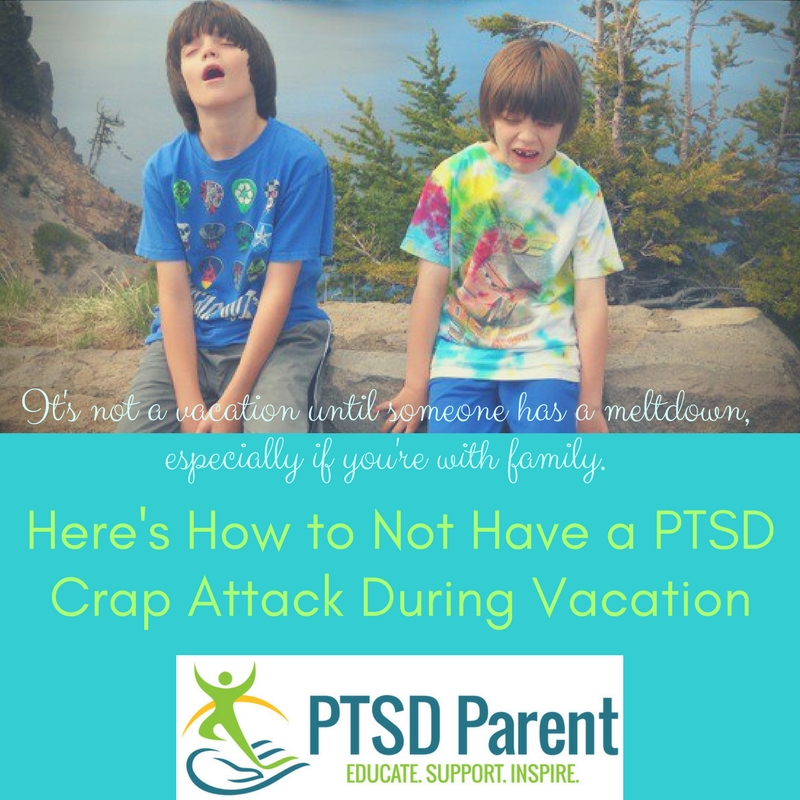
It’s not a vacation until someone has a meltdown, especially if you’re with family. This can be even more of a certainty for those of us with Post Traumatic Stress Disorder.
Lately, I like to refer to my PTSD trigger events as “crap attacks.” First, it makes me laugh. Second, I got it from the TV show Bob’s Burgers, which I binged on during the last year and it is now one of my favorites. I believe the line was spoken by Tina – a teenager – who said, “Geez, Mom and Dad, don’t have a crap attack.” Since I have teenagers, I busted a gut so hard my kids now randomly yell out, “Crap attack!”
My PTSD “crap attacks” can show up even on the most relaxing or fun vacation. Here are some ways that we can take care of ourselves to avoid PTSD triggers during this down time.
[Tweet “Here are some ways that we can take care of ourselves to avoid PTSD triggers during vacations.”]
Manage Expectations of the Vacation
Some vacations do not feel like my idea of a “vacation.” I move at a slower pace than most people. While I enjoy and appreciate adventure, I’m also up for hours in the sun by the pool, dozing and reading. Others in my family – with whom I love to spend time – do not appreciate all of this down time; they like to stay on the move.
For example, when we go to Disneyland with the high school band, I know that I’m not going to have hours by the pool. I know that it will be an exciting and busy series of days, which I will enjoy, but can also make me cranky. I know that the crowds and music and heat will get to me after awhile, and I’ll probably hide somewhere – even in the nearest bathroom. Not my ideal, but managing my expectations for the vacation ahead can help me keep my emotions in check.
I don’t need to plan out every day of my vacations, but I do like to be prepared before I get there. I check out the weather, the hotel, and read up on any of the places we plan to visit. This helps me manage my expectations for the days ahead.
Bring Comforting Stuff
 Hotels can feel sterile to me, even when they’re nice. I don’t know about you, but I can never have enough blankets and pillows. I always pack a thin but comfy and familiar blanket with me, along with my favorite pjs, snacks, books (on my Kindle to make packing easier), and even a couple of movies or shows I can stream.
Hotels can feel sterile to me, even when they’re nice. I don’t know about you, but I can never have enough blankets and pillows. I always pack a thin but comfy and familiar blanket with me, along with my favorite pjs, snacks, books (on my Kindle to make packing easier), and even a couple of movies or shows I can stream.
Sometimes new surroundings can be overwhelming, and coming back to our familiar and favorite things can be very comforting. When I feel extra tired and my defenses are down, I can take a time out with a good book or one of my favorite shows, do some meditation, eat a filling snack, and be ready to head out again.
Do the Boring Stuff
It’s really tempting to have the “Hey, It’s Vacation!” mindset about everything, this may not be the best choice. At least, it’s not sustainable for me. Sure, I can eat a bacon burger and drink a couple of beers and miss my meds for a day and stay up until 2 a.m., but I will pay the consequences.
That’s the hard truth that I need to remember. I make choices and there are consequences. When I don’t do the typical self-care routines that keep me sane, my defenses can fail and PTSD crap attacks are more likely to occur.
On vacation, I try to do as many routine things as possible. If I don’t go to bed at the same time I usually do at home, that’s cool, but I need to try and get eight to ten hours of sleep. I eat regularly throughout the day – more often if we’re walking all day long, like at an amusement park. I pack my meds where I can see them, making them easy to find and take each day. While it’s tempting to skip out on this boring stuff, it can help reduce the chances of a PTSD trigger event.
Take a Time Out
 Since I get overwhelmed in my own home, it’s reasonable to expect that I may be overwhelmed at some point while on vacation. Regardless of where I’m vacationing, I plan one evening that I call, “Introvert Night!”
Since I get overwhelmed in my own home, it’s reasonable to expect that I may be overwhelmed at some point while on vacation. Regardless of where I’m vacationing, I plan one evening that I call, “Introvert Night!”
Instead of hanging out with everyone else, I stay in my room and enjoy the quiet. Taking advantage of the clean bathtub, I take a soothing bath. I enjoy room service, splurging a little on dinner. I watch a movie or two and read. If there are other introverts that I’m traveling with, I invite them into my sanctuary…or I don’t. It just depends on what I need.
Vacations offer us a chance to manage our PTSD so that we won’t have any pesky crap attacks while we’re trying to relax. Take some time to plan what you might need so that you can make the most out of your vacation.
The post How to Not Have a PTSD Crap Attack During Vacation appeared first on PTSD Parent.
]]>The post 7 of the Best PTSD Parent Blog Posts of 2017 appeared first on PTSD Parent.
]]>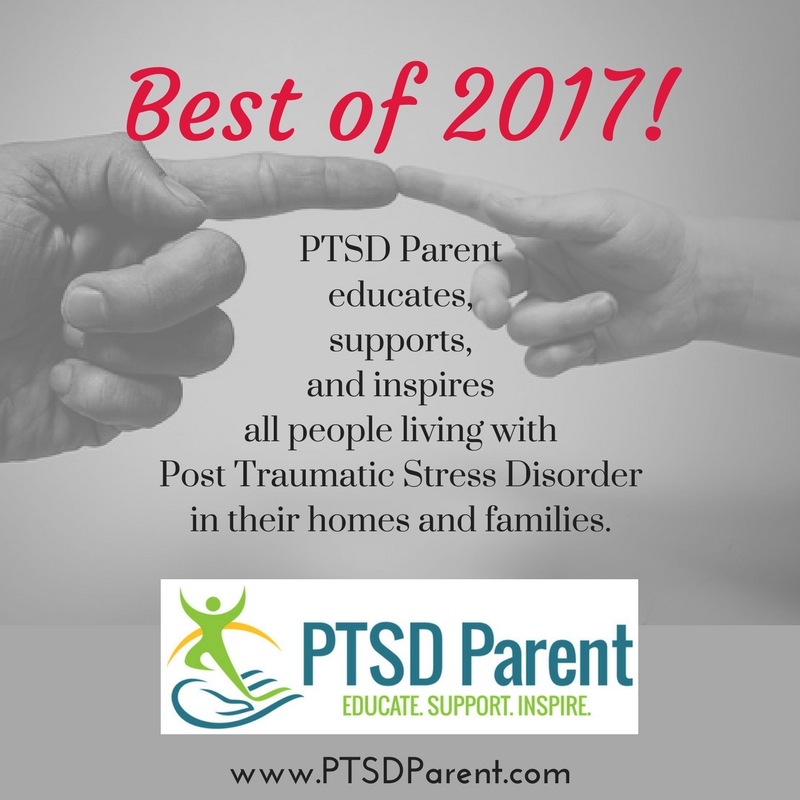 I can’t believe that it’s already been a year since PTSD Parent was born. One morning last December, I woke up with “PTSD Parent” on my mind and knew that I wanted to make this idea a reality.
I can’t believe that it’s already been a year since PTSD Parent was born. One morning last December, I woke up with “PTSD Parent” on my mind and knew that I wanted to make this idea a reality.
I trekked through the snow to my PTSD partner’s house, telling him about my idea, and we got a logo and website going. By the first week of March, PTSD Parent was a reality! It feels like a lifetime ago, because quite frankly, 2017 sucked hard. One of the most challenging years of my life, I’m not kidding. And this is from me, the person who wrote Caskets From Costco, which is a book about trauma and grief and my PTSD journey. So you know it was tough.
But 2017 was also one of the most amazing years when it came to growth, love, community, relationships, and moving from surviving to thriving. I’ve shared more about my post traumatic stress disorder and healing from abuse than I ever have before. I continue to learn the best ways to take care of myself, use my voice, and advocate for myself.
But what I am most grateful for is the chance to meet people like you, who experience PTSD in some form on a regular basis. Whether you have been diagnosed yourself or love someone who is diagnosed with post traumatic stress disorder, I am so glad you have joined us on this journey.
To celebrate the end of this year and welcome 2018, enjoy the seven best PTSD Parent blog posts of 2017!
7. The Self-Care Acronym That Will Rock Your World – What does self-care really mean? I would stop and figure out what it really means to actually take care of myself only to forget, so I made up a self-care acronym to help.
6. How To Stay Safe: PTSD Triggers and the Holidays – December isn’t the only holiday time of year. Here are some good tips to stay calm and safe, including how to make a holiday plan for PTSD triggers.
5. Simple Self-Care Tips When You Want to Give Up – What do you do on those days when you’re not okay?
4. What to Do When Parenting With PTSD Sucks – Parenting with PTSD can really suck sometimes. But you are not alone.
3. Stop Telling Me That You Know the Cure for PTSD – This is a good one, in which I rant about how someone told me that they had the cure for PTSD.
2. The Best Way to Avoid Avoidable PTSD Suffering – Should I see this person again? Aside from “shoulding” all over myself, I knew that the answer to this question was a resounding “NO.”
1.PTSD Can Be a Gift for Grieving – I don’t often think of PTSD with regards to all of the gifts it gives me. Grieving is a cleansing side effect of my post traumatic stress disorder.
Happy New Year! Bring on 2018!
Searching for Hope and Inspiration? Check Out Caskets From Costco

A Funny and Poignant Grief Book
For twenty years, I thought that I had been marching through the stages of grief in a straight line. I had been following the formula, crossing each processed grief experience off my list.
Except that I was totally deluded. And I didn’t discover that until Jim, my beloved father-in-law, died. I found myself drying off from my shower the morning after his death, really hoping he couldn’t see me naked. Or, if he could, that he was averting his eyes.
From that moment, my path through grief resembled a roller coaster, spiraling and twisting and turning, circling back around. Echoes of past trauma, including childhood abuse and cheating death, would no longer be ignored. I somehow needed to get from the beginning to the end of this grief adventure, and I don’t have a good sense of direction.
But what is always present during a journey through grief, regardless of the path chosen?
Hope.
Caskets From Costco is a funny grief book that demonstrates the certainty of hope and healing in an uncertain and painful world.
Go Here to Read a Free Excerpt of Caskets From Costco!
The post 7 of the Best PTSD Parent Blog Posts of 2017 appeared first on PTSD Parent.
]]>The post How To Stay Safe: PTSD Triggers and the Holidays appeared first on PTSD Parent.
]]>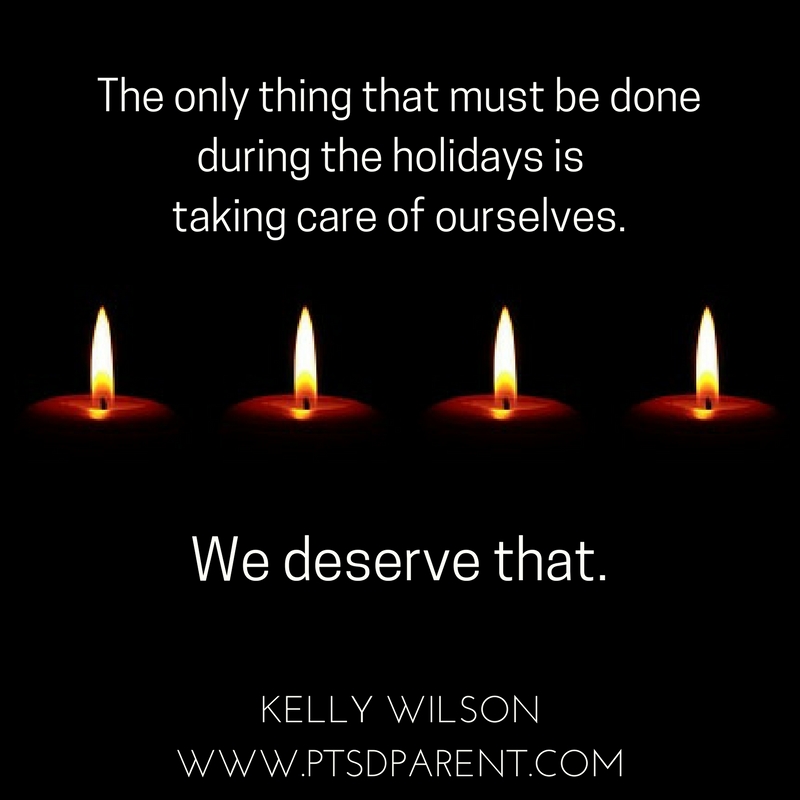
Every Christmas, like clockwork, I would get sick. Down for days, major flu-like symptoms, eventual antibiotics needed. This happened every single year during my twenties, when I didn’t understand that the holidays season was the major time of year for my PTSD triggers.
[Tweet “My brain and body enter into an extended PTSD event, a heightened undercurrent of symptoms.”]
Holidays and PTSD Triggers

For me, the holidays are a specifically traumatic time for my post traumatic stress disorder. A large block of the sexual abuse that I remember occurred between mid-November and the beginning of January. And this is just what I remember. As we eat the candy from our Halloween buckets and the leaves fall from the trees, my brain and body enter into an extended PTSD event, a heightened undercurrent of symptoms.
I rarely get sick anymore during this time of year, which I consider an improvement. My acknowledgement of the effects of the trauma I endured helps me to put plans in place to help keep me as healthy and whole as possible from November to January 2nd. Part of this practice is to be honest about my PTSD symptoms, and that I am simply more sensitive during this time of year.
I am far more irritable. Tired, both physically and emotionally. Angry. Depressed. Anxious. It’s hard to get moving, even out of bed each morning. My startle reflex is more pronounced. I hate the colored lights and the holiday music that are everywhere. The days are short and light is scarce. I am more tempted to try and use food and alcohol to deal with the symptoms.
I may not like it, but this is my reality during the holiday season.
Make a Holiday Plan for PTSD Triggers
[Tweet “I have a specific self-care plan in place for when PTSD triggers are the worst.”]
 I’ve tried a variety of strategies to deal with the PTSD symptoms. For awhile, I simply tried to ignore them. I pretended to love the holiday season.
I’ve tried a variety of strategies to deal with the PTSD symptoms. For awhile, I simply tried to ignore them. I pretended to love the holiday season.
I don’t.
Okay, so I’m the Grinch. I can live with that, if it means I come out of this annual undercurrent of heightened PTSD symptoms sane and physically well. In order for that to happen, I have to make a self-care plan for this time of year, in addition to the typical Take My Meds, Eat Healthy Food, Exercise, and Sleep.
I need to make sure that I have a specific self-care plan in place for when PTSD triggers are the worst.
How to Make a Holiday Plan for PTSD Triggers
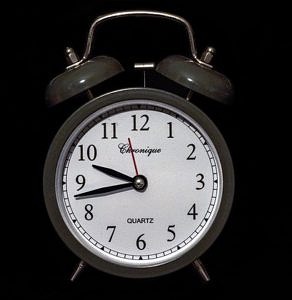 Okay, so we need to make a holiday self-care plan. This might seem overwhelming, but do not fear. Here’s mine for this year, hopefully it will help.
Okay, so we need to make a holiday self-care plan. This might seem overwhelming, but do not fear. Here’s mine for this year, hopefully it will help.
Decide what you will not do. Many times, deciding what you will not do is far easier than figuring out what you are willing to do. For example, I do not go to holiday parties, shop in the mall, or drive on busy streets. From mid-November until January 2nd, I am mostly at home. I will not try something new. I make no promises to be anywhere or with anyone – I play everything by ear.
Schedule everything, including rest. Get out your calendar, it’s time to fill in some details. Figure out a weekly meal plan for the next month or so. Schedule when you will exercise, even if it’s a 10-minute walk each day. Put in your sleep hours and when you take your meds. When will you go grocery shopping? For example, I go every Sunday afternoon. Do not forget to schedule down time, especially as the calendar fills up with the kids’ holiday concerts.
Practice typical self-care strategies with extra vigilance. I know that staying away from dairy and sugar help keep my depression manageable, so I am extra-vigilant about avoiding them during this time of year, which can be challenging. I also limit the amount of “treats” that I make and when I make them. I go to bed early and walk every day.
Ask for help. While I revile the holiday season, I do like to shop for people. I do the bulk of my shopping online. If there are gifts that I can’t pick up during my weekly grocery trip to Fred Meyer, I ask my husband or a trusted friend to help me out. I also don’t wrap or deliver presents – that’s what the husband and kids are for.
Focus on what you love – Okay, so I hate the holidays. I’ve admitted it. But I love my family. I love spending time with my kids. I invite them to do what I can do during this time of year, whether that’s going to the movies or my weekly grocery shopping trips or reading on the couch.
Remember, the only thing that must be done during the holidays is to take care of ourselves. We deserve that.
The post How To Stay Safe: PTSD Triggers and the Holidays appeared first on PTSD Parent.
]]>The post How to Be Calm: PTSD and Halloween appeared first on PTSD Parent.
]]> “Hey, Mom, you should come see me at the haunted house,” joked my 15-year-old manchild. He was volunteering at our community’s traditional Halloween fundraiser at the Elks Lodge. (Side note: The haunted house theme is “Asylum,” which is a whole different level of rage for someone like me, working in mental health. We petitioned to get the theme changed, but it fell on deaf ears.)
“Hey, Mom, you should come see me at the haunted house,” joked my 15-year-old manchild. He was volunteering at our community’s traditional Halloween fundraiser at the Elks Lodge. (Side note: The haunted house theme is “Asylum,” which is a whole different level of rage for someone like me, working in mental health. We petitioned to get the theme changed, but it fell on deaf ears.)
“People with Post Traumatic Stress Disorder don’t visit haunted houses,” I said with a smile.
He does, of course, know this, and we joke about it because humor is my primary coping skill. And while I joke around about feeling stressed during Halloween, I’m very serious about how this time of year has an effect on my own PTSD.
[Tweet “Making a plan to stay calm and manage PTSD symptoms is an act of self-care.”]
Tough PTSD Symptoms During Halloween
Halloween can be a tough time for individuals with mental health challenges. While there are parts of this holiday that I enjoy – the decorating for the season, spending time with friends and family, candy – there’s stuff that is just plain disturbing.
While Halloween can be an innocent time of costumes and a wide variety of free candy, there’s a celebration of the darkness associated with October 31st. The blood and gore and jumpscares and hauntings and demons and scary movies. All of these can set off our PTSD symptoms, some of which include:
- Hypervigilance – Feeling like you have to be constantly “on guard” is exhausting. The constant adrenaline and stress hormones are harmful after long periods of time, and it can be really difficult to come down from the Flight-Fight-Freeze response. People at the door triggers my anxiety, especially as my dog starts barking and won’t stop.
- The Startle Reflex – I have the startle reflex when someone comes around a corner on a regular day, so forget people dressing up in scary costumes and losing all sense of personal space. Jumpscares are the worst on a good day.
- Sensitivity to Sound – I am highly sensitive to noise, and my threshold for tuning it out is getting lower as I get older. I’m also noticing that my sensitivity extends to other stimuli – lights, people, smells – so I have to closely monitor what’s happening around me and when I need a break.
Make a Plan for Calm During Halloween
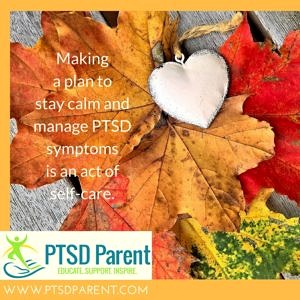 It can be difficult to simply remain calm during primetime Halloween trick-or-treating hours or during holiday parties, especially if your home is your safe space. Making a plan to stay calm and manage PTSD symptoms is an act of self-care. Here are some strategies I use to keep from losing my sh*t during Halloween.
It can be difficult to simply remain calm during primetime Halloween trick-or-treating hours or during holiday parties, especially if your home is your safe space. Making a plan to stay calm and manage PTSD symptoms is an act of self-care. Here are some strategies I use to keep from losing my sh*t during Halloween.
- Don’t Go – As I told my son, people with PTSD don’t go to haunted houses. I rarely go to Halloween parties. I
- Plan a Date – This date doesn’t have to be with another person; you can simply take yourself out for a special date. Go out to a restaurant for a couple of hours and then to the movies. Book a massage. Get your nails done, especially a pedicure. Head to the grocery store and run other errands.
- Make Your Own Noise – Hide in your room and put on noise-canceling headphones. Listen to the silence or play music. Watch a movie with the sound coming through your headphones. Turn on a really loud fan or a white noise machine to help drown out any other disturbances.
- Hang Out With a Friend – Preferably a friend who lives in the country where people don’t go trick or treating.
- Get Involved in a Project – Using your hands and brain can provide a distraction from anxiety. Choose a favorite type of project to do to keep your mind occupied, preferably one that requires a lot of concentration or has several steps to keep you focused.
Like most things, Halloween can be both joyous and difficult. However this time of year breaks down for you, hopefully you can make a plan for peace so that you can enjoy what you love about Halloween. Yes, including candy!
The post How to Be Calm: PTSD and Halloween appeared first on PTSD Parent.
]]>The post How to Let #Grief to Break Through the #PTSD Chaos appeared first on PTSD Parent.
]]>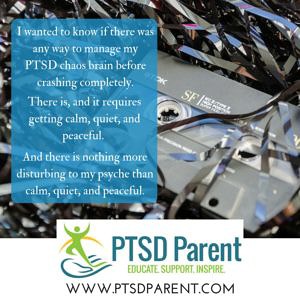 PTSD makes chaos feel at once jarring and comforting.
PTSD makes chaos feel at once jarring and comforting.
As a survivor of childhood sexual (and other forms of) abuse, I grew up in constant chaos. I never knew from one day, hour, or moment to another how things were going to shake out. It was impossible to know whether my dad would come home drunk or in a rage, or both. If my mother would make me clean the bathtub for hours, berating me until she decided she was done. If we would have food or not. Or if everything would be fine, but in a calm-before-the-storm way, with lightning in the air that makes the hair on your neck and arms stand up on end.
One of the curses of Post Traumatic Stress Disorder is feeling completely uncomfortable with peace and quiet, and in my element when there’s chaos in and outside of my head.
Managing the PTSD Chaos Brain
One of the themes of my life over the last several years is my apparent inability to pace myself. I go gung-ho, get really excited, go go go some more, keep going even when I need to stop, and then crash in a blaze of glory. I like to tell myself that I don’t really know my limits until I push against them and then fail to take care of myself.
[Tweet “I like to tell myself that I don’t really know my limits until I push against them and then fail.”]
And to a certain extent, this is true. I know – and respect – more of my limits now than I did a year ago. And I have learned the hard way, friends. But I wanted to know if there was any way to get in front of it, to manage the chaos brain before gearing up into out-of-controlness and crashing completely.
There is, and it requires getting calm, quiet, and peaceful. And there is nothing more disturbing to my psyche than calm, quiet, and peaceful.
Getting Quiet in the PTSD Chaos Brain
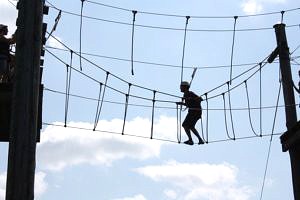 Two instances reminded me about how valuable it is to get quiet in order to break through the PTSD chaos brain. The first one was at my youngest son’s birthday party. We took him to a family fun center, and we spent the afternoon enjoying playing arcade games, driving go karts, playing miniature golf, and tromping around the ropes course…a million feet in the air.
Two instances reminded me about how valuable it is to get quiet in order to break through the PTSD chaos brain. The first one was at my youngest son’s birthday party. We took him to a family fun center, and we spent the afternoon enjoying playing arcade games, driving go karts, playing miniature golf, and tromping around the ropes course…a million feet in the air.
Okay, maybe not a million feet, but enough to make me think seriously of just taking my harnessed self back down the stairs and avoiding the whole thing. Instead, I made Husband go in front of me, across these bouncy, uneven wooden squares that took us from one side to the other. I don’t know exactly how high it was, but it was enough to make me check the safety harness. Twice.
I started to panic, one foot on the steady platform, one foot on the bouncy and wobbly step. I couldn’t help but look down, as I had to see where I was going with each step. I took a deep breath. And another one.
I felt myself go inward with each breath, not disconnecting in the PTSD-dissociative way, but connecting deep in my gut. This was scary, but I could cope. With every breath, I took another wobbly step and found my balance on each of the four sides of this ropes course.
In the midst of the chaos, I had found my calm.
How Grief Broke Through the PTSD Chaos
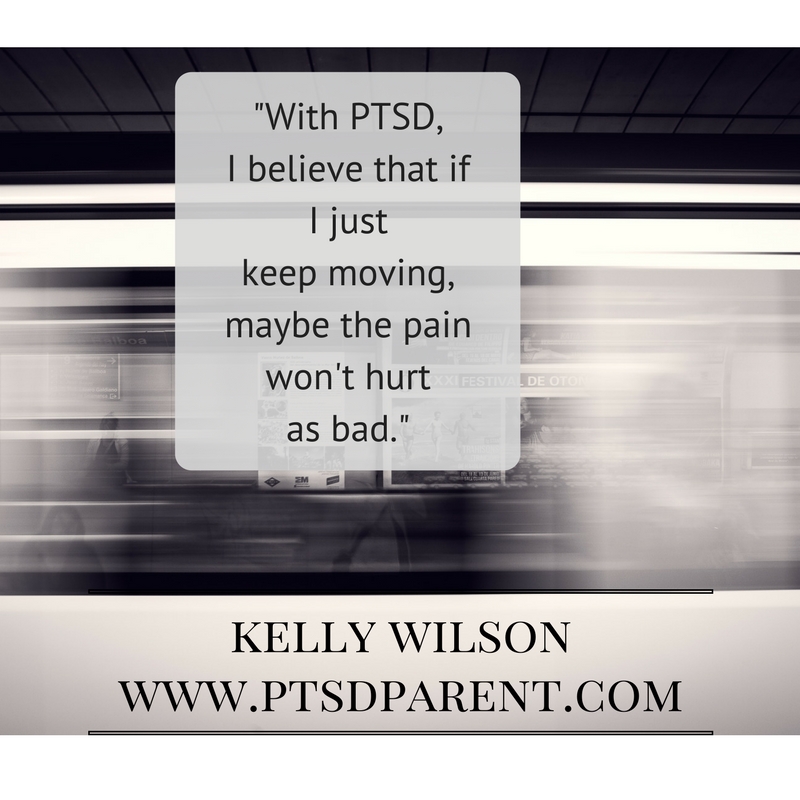 The other instance of finding my peace in chaos was simply more painful. It was Mother’s Day.
The other instance of finding my peace in chaos was simply more painful. It was Mother’s Day.
I find every holiday difficult, except for Halloween. I like seeing all my neighbors and their kids and the talking and laughing and sense of community. The rest of the holidays, however, can kiss my butt. Mother’s Day is one of those.
I usually have a plan for each holiday, regarding how I will take care of myself. This last Mother’s Day, though, I was just so tired. It’s like when I do all that self-care work and still feel like shit, only less so, or for less days or hours in a row.
I didn’t want to do anything, so I stayed in bed for most of the day. And for most of the day, I liked it. I watched some movies, ate my favorite toast, drank coffee, took my meds, played Candy Crush – it was wonderful. Late in the afternoon, though, all the numbing and coping wore off.
I reached out to Husband, who sat with me, arms around me. “Maybe we’ll go for a walk,” I said.
“Do you want to go for a walk because you want to, or because you think you should?” he asked.
I was quiet for a moment. The spinning chaos in my brain slowed down. I drilled down, inward, into the calm, connecting with my gut. “I think that I believe that if I just keep moving, maybe the pain won’t hurt as bad.” And, you guessed, I started to ugly-cry.
The pain was sharp in my chest, balanced by relief and calm. For awhile, grief helped me break through the PTSD chaos.
About PTSD Parent
We’re glad you found us! PTSD Parent educates, supports, and inspires all people living with Post Traumatic Stress Disorder in their homes and families. At PTSD Parent, you can find helpful resources if you are a parent with PTSD, if you have a child with PTSD, and if you are a friend or family member of a loved one with this diagnosis. You can find out more about PTSD Parent and go here to sign up for email updates!
The post How to Let #Grief to Break Through the #PTSD Chaos appeared first on PTSD Parent.
]]>The post The Self-Care Acronym That Will Rock Your World appeared first on PTSD Parent.
]]> Self-care is a term that’s been thrown around a lot in the mental health world. When I heard the words “self-care,” I nodded, I agreed that it was important, and I went on my way.
Self-care is a term that’s been thrown around a lot in the mental health world. When I heard the words “self-care,” I nodded, I agreed that it was important, and I went on my way.
Until I couldn’t put off figuring out the meaning of those words anymore. Having kids who required me to be present really made me stop and figure out what it really means to actually take care of myself. Once a figured out what I needed, however, I would forget, so I made up a self-care acronym to help.
Self-Care is Individual
The great thing about learning how to take care of yourself is that you can tailor your self-care plan to fit your needs. I like getting pedicures and massages on a regular basis, but this may not be your thing. You may like to take a run when you’re feeling overwhelmed and I’m like, thank you, no, I’ll walk. My personal self-care acronym may not work for you, but it’s a starting point to figure out exactly what you want to do for self-care.
The point is figuring out what really helps you to feel better, to hang in there, to have hope. I watch The Office. I avoid eating or drinking dairy products. I make a blanket and pillow fort in my bed and play Candy Crush. Every time I have taken a time out and used my self-care acronym, I’ve emerged feeling better than before.
[Tweet “Self-care is figuring out what really helps you to feel better, to hang in there, to have hope. “]
Self-Care is All About Making a Plan
For me, my post traumatic stress disorder (combined with depression and anxiety) can flair up at any time. I might wake up feeling fine and then the day will crash around me in a fiery mess. Or I might begin the day fresh from a nightmare and it all gets worse from there. Or nothing will happen and the day will be what some people call “normal.”
Different levels of self-care are required for different days. If I’m sobbing at my computer by ten o’clock in the morning due to an unexpected trigger, then more intentional self-care is required that day.
I don’t wait until I’m sobbing or in the fiery mess to try and figure out what “self-care” looks like for me. At that point, I simply do not care. Instead, I have made a simple four-step self-care plan that helps me at anytime, especially when everything goes to crap.
[Tweet “I have made a simple four-step #self-care plan that helps me at anytime. #ptsd”]
The Four-Step Self-Care Acronym
I came up with this acronym through learning how to manage my triggers. Actually, I came up with it because I could not even with this parenting stuff and one day asked myself, “What is the bare minimum that I need to do today in order to take care of myself?”
This is what I came up with. And after ten-plus years as an educator in the public school system, I am fairly addicted to creating acronyms. Seriously, there is an acronym for everything when you are a teacher.
So what is the magical acronym that will literally rock your world? It is SEEM. It helps me deal with those times when it “SEEM”s like it’s going to be a challenging day. Because post traumatic stress disorder does not care if you are ready to deal, it just happens.
And when it does happen, you can be ready to act. What are the four self-care steps you need to do today? Sleep, Eat, Exercise, and take your Meds.
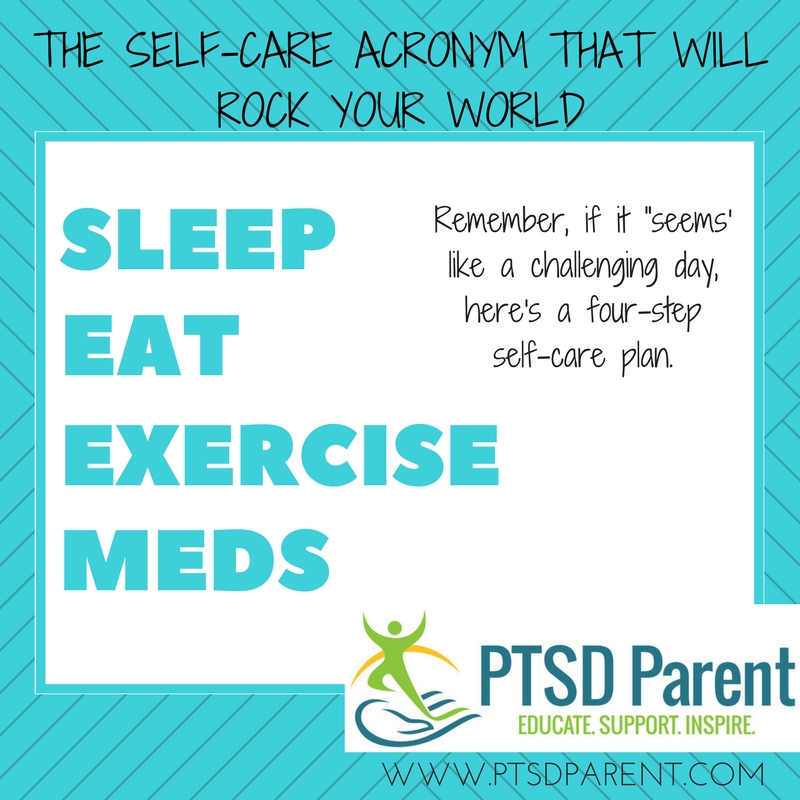
Don’t panic about the Exercise part, though. For me, this means moving my body in literally any fashion. It could be going grocery shopping or doing one push up. I make the simplest fitness goal that I can for that day, and I always succeed. And guess what? Once I start moving, I usually keep going…and then I feel better.
How do you take care of yourself, especially during challenging mental health days? Leave a comment and let us know!
About PTSD Parent
We’re glad you found us! PTSD Parent educates, supports, and inspires all people living with Post Traumatic Stress Disorder in their homes and families. At PTSD Parent, you can find helpful resources if you are a parent with PTSD, if you have a child with PTSD, and if you are a friend or family member of a loved one with this diagnosis. You can find out more about PTSD Parent and go here to sign up for email updates!
The post The Self-Care Acronym That Will Rock Your World appeared first on PTSD Parent.
]]>The post The Best Way to Avoid Avoidable #PTSD Suffering appeared first on PTSD Parent.
]]>“Nobody is ever a victim!” she exclaimed. “There’s always that small voice that you don’t listen to or clues that you choose to ignore.” She paused, finishing with, “Nobody is *ever* a victim!”
I sat on the edge of the table, my back bare and the straps of my bra falling from my shoulders. I had been telling her about my background with trauma and post traumatic stress disorder (PTSD) in context of recent challenges. I felt at war with my emotions, particularly anger, and was hoping for help from her to deal with them on a physical level. Hence, the acupuncture.
I felt vulnerable, exposed, with needles sticking out of my skin and along my spine. My PTSD is a result of childhood sexual abuse and related trauma, all of which had happened *to* me. I didn’t have clues that I ignored.
I felt blamed. Immediately and thoroughly. Which happens to be one of my PTSD triggers.
She soon left the room to allow me to rest with the needles in different parts of my body. I cried – big, wracking sobs that eventually calmed into rivers of tears. I spoke as little as possible until I could get out of there.
Dealing with the Unexpected Trigger

I left the appointment feeling prickly, as if she had left needles in different parts of my body that had access to my emotions. I was confused and unsure of what I had heard. So I did what anyone would do in the situation – I put it on Facebook.
It struck a nerve, garnering more than 30 comments from various friends of mine. Many of the comments were thought-provoking:
“It makes me wonder what happened in her life that she still blames herself for.”
“I’m glad somebody felt safe enough to tell you what was on their mind. That is a gift you have.”
“Regardless of how anyone got into a situation, if they are abused then they are a victim.”
“This might be one of the most literal forms of victim blaming I’ve ever come across.”
And my favorite one: “Did you punch her in the throat and ask if she saw that clue coming or picked up on the sign??? Oh my GOSH! Amazed you or anyone had self control in that situation. I applaud you for being the better person and walking away from ignorance.”
Victim blaming is a largely accepted form of prejudice, but it surprised me to come face to face with it in this setting. We had discussed PTSD during my previous appointments, and she seemed to accept my diagnosis. I had made the assumption, however, that a professional in this branch of health care would be accepting. In this instance, I was wrong.
Even though I knew that I never wanted to see her again, I asked myself, “Should I go back?”
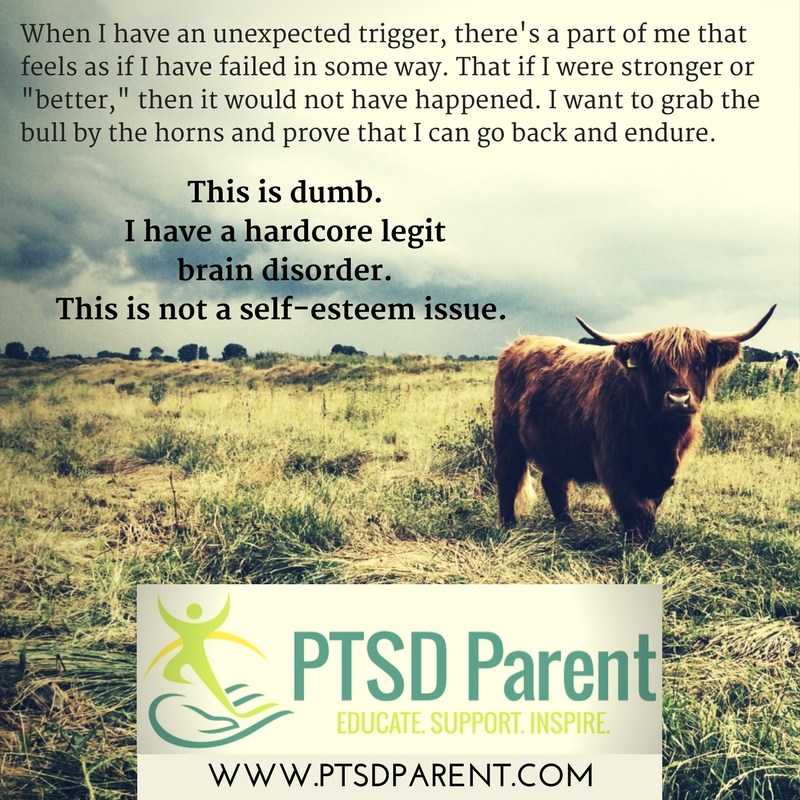
Avoid Avoidable Suffering
Aside from “shoulding” all over myself, I knew that the answer to this question was a resounding “NO.” I got more validation at my next PTSD group. The topic was – just guess – dealing with unexpected and expected triggers.
The best way to avoid avoidable suffering is to say this over and over again: Do Not Test the Trigger.
When I have an unexpected trigger, there’s a part of me that feels as if I have failed in some way. That if I were stronger or “better,” then it would not have happened. I want to grab the bull by the horns and prove that I can go back and endure.
This is dumb. I have a hardcore legit brain disorder. This is not a self-esteem issue.
Do Not Test the Trigger. Would you party with an alcoholic in a bar? No. Why? Because alcohol is a trigger that does not need to be tested.
Would I party with this acupuncturist? No. Because seeing her would probably be a trigger. I don’t need to test it. Plus, I don’t want to hang out with her. At all.
Searching for Hope and Inspiration? Check Out Caskets From Costco

A Funny and Poignant Grief Book
For twenty years, I thought that I had been marching through the stages of grief in a straight line. I had been following the formula, crossing each processed grief experience off my list.
Except that I was totally deluded. And I didn’t discover that until Jim, my beloved father-in-law, died. I found myself drying off from my shower the morning after his death, really hoping he couldn’t see me naked. Or, if he could, that he was averting his eyes.
From that moment, my path through grief resembled a roller coaster, spiraling and twisting and turning, circling back around. Echoes of past trauma, including childhood abuse and cheating death, would no longer be ignored. I somehow needed to get from the beginning to the end of this grief adventure, and I don’t have a good sense of direction.
But what is always present during a journey through grief, regardless of the path chosen?
Hope.
Caskets From Costco is a funny grief book that demonstrates the certainty of hope and healing in an uncertain and painful world.
Go Here to Read a Free Excerpt of Caskets From Costco!
The post The Best Way to Avoid Avoidable #PTSD Suffering appeared first on PTSD Parent.
]]>